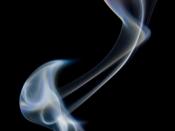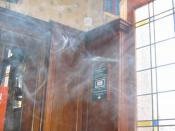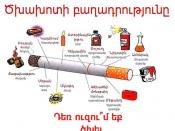Tar
Tar is a sticky brown substance produced by cigarettes that can stain a smoker's fingers and teeth yellow/brown. It is also sometimes known as total particulate matter and is inhaled when a cigarette is smoked. Some of the chemicals in tar include benzene and benzo(a)pyrene.
Tobacco Smoke
Tobacco smoke contains many harmful gases that can be damaging to the body such as carbon monoxide, formaldehyde, hydrogen cyanide, ammonia and acrolein.
Passive Smoking
Passive smoking is involuntary smoking by non-smokers inhaling the smoke of others. Smoke emitted from a lighted cigarette can be split into two types; mainstream smoke and sidestream smoke. Mainstream smoke is the smoke that the smoker inhales through the cigarette and sidestream smoke is the smoke that comes from the lit end of the cigarette. Up to 85% of smoke in a room where a cigarette has been smoked is sidestream smoke and this is the smoke that is inhaled by non-smokers.
Often passive smoking can be more harmful that actual smoking because sidestream smoke is unfiltered and still contains many harmful smoke particles that mainstream smoke does not have due to the filter that most cigarettes have attached to them.
Nicotine
Nicotine is the addictive substance in cigarettes, it is what causes a smoker to crave another cigarette and therefore carry on the habit. The more nicotine a smoker consumes, the more they will crave and so the more they will smoke. This means that they will be inhaling more toxic substances into their body, particularly the lungs, and this affects the breathing system as these substances will damage the lungs and cause a reduction in their ability to function properly.
Carbon Monoxide
One of the main functions of the respiratory system is to provide the body with oxygen so that it can be delivered...


